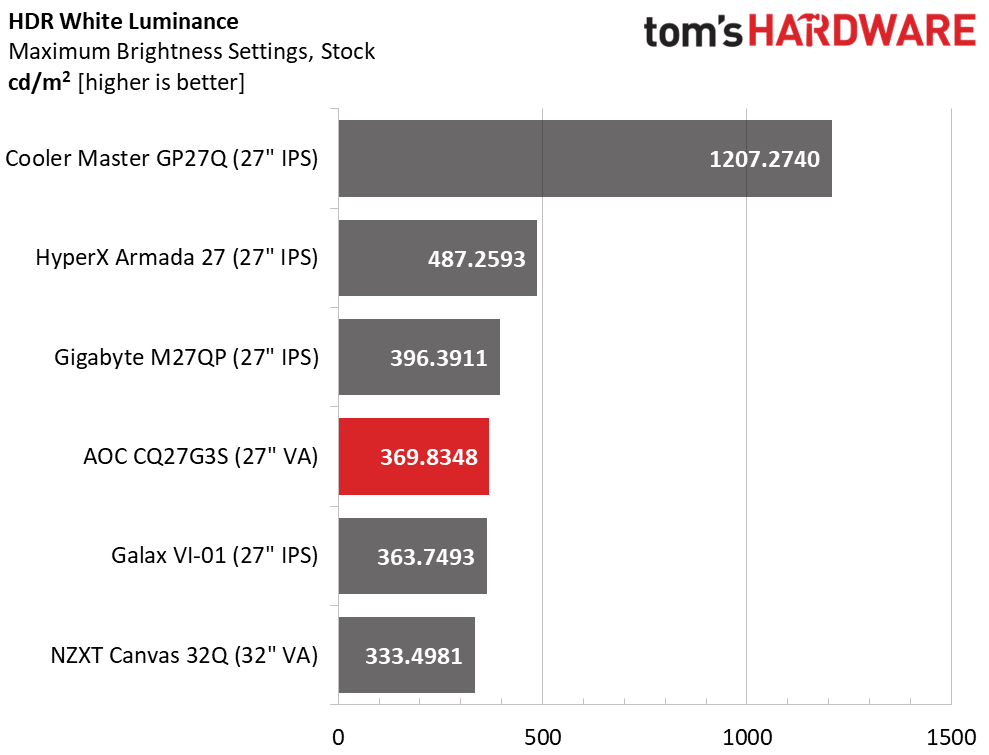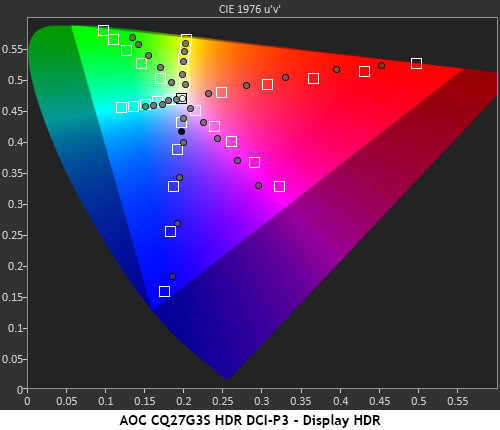Why you can trust Tom's Hardware
Our HDR benchmarking uses Portrait Displays’ Calman software. To learn about our HDR testing, see our breakdown of how we test PC monitors.
The CQ27G3S fully supports HDR10 signals with an automatic switchover. There are four HDR modes, of which two, Display and Game, are very accurate.
HDR Brightness and Contrast



The CQ27G3S doesn’t come with any sort of VESA HDR certification but at over 369 nits peak, it’s a worthy HDR display. Dynamic range is more important than sheer output and there is plenty of that here. If you want 1,200 nits like the GP27Q has, you’ll spend more than double the money.
The AOC and the NZXT both make do without any sort of dynamic contrast feature, so their contrast ratios are about the same for SDR and HDR. This does not mean that SDR and HDR look the same. Since they properly follow the HDR luminance curve, AKA the EOTF, their high native contrast results in an impactful HDR effect.
The only way to see a better HDR image is with a Mini LED like the GP27Q which has an unmeasurable black level. Or an OLED, of course. For $250 though, the CQ27G3S absolutely rocks in HDR mode.
Grayscale, EOTF and Color






With most monitors, any mode called Display HDR will be the most accurate. But in the CQ27G3S’s case, I found a few anomalies that led me to test HDR Game as well. In the grayscale test, the results are similar between the two modes. The main difference is that in HDR Game mode, shadows and midtones are a bit lighter than in Display HDR.
The big one for me is in the color test where HDR Game is significantly more saturated. It’s hard to choose Display HDR once you’ve done an A/B comparison. The CQ27G3S exhibits the same behavior for both DCI-P3 and Rec.2020 references. The only drawback to HDR Game is some added edge enhancement which cannot be removed. This lowers perceived resolution a little but for me, it was an acceptable compromise.
Get Tom's Hardware's best news and in-depth reviews, straight to your inbox.
Test Takeaway: The CQ27G3S delivers some of the best HDR image quality I’ve seen from a budget monitor. Its high native contrast means deep blacks and highlights that pop. Though the HDR Game mode has some edge enhancement that reduces perceived resolution, its superior color makes it the better choice.
MORE: Best Gaming Monitors
MORE: How We Test PC Monitors
MORE: How to Buy a PC Monitor
MORE: How to Choose the Best HDR Monitor

Christian Eberle is a Contributing Editor for Tom's Hardware US. He's a veteran reviewer of A/V equipment, specializing in monitors. Christian began his obsession with tech when he built his first PC in 1991, a 286 running DOS 3.0 at a blazing 12MHz. In 2006, he undertook training from the Imaging Science Foundation in video calibration and testing and thus started a passion for precise imaging that persists to this day. He is also a professional musician with a degree from the New England Conservatory as a classical bassoonist which he used to good effect as a performer with the West Point Army Band from 1987 to 2013. He enjoys watching movies and listening to high-end audio in his custom-built home theater and can be seen riding trails near his home on a race-ready ICE VTX recumbent trike. Christian enjoys the endless summer in Florida where he lives with his wife and Chihuahua and plays with orchestras around the state.
-
Friesiansam Reply
Not only is that too tight for a curve radius, who needs a curve anyway, on a 27" monitor?tennis2 said:1000R curve = nope.
